In the right situation, most of the feats in 5E can be incredibly powerful for players, and a headache for the DM. While I won’t go so far as to call most feats “broken,” depending on the type of DM you are, how much you struggle to adapt to certain challenges, and the campaign involved, some of these can certainly cause major headaches.
In fairness before diving into this list I will say this: a lot depends on the relationship of the DM and the players and how he sees the role. Does your table tend to have an “Us vs. the DM” sort of antagonistic setup?
Is the DM very accommodating to create the canvas for the story being told while letting the players’ characters really take the lead? Is it something in the middle?
None of these is wrong: I’ve had a lot of fun in campaigns with each type of DM. But it changes your definition of “Bane of the DM.” DM style matters, too. Some people argue that Keen Mind is the stupidest and most worthless feat of all.
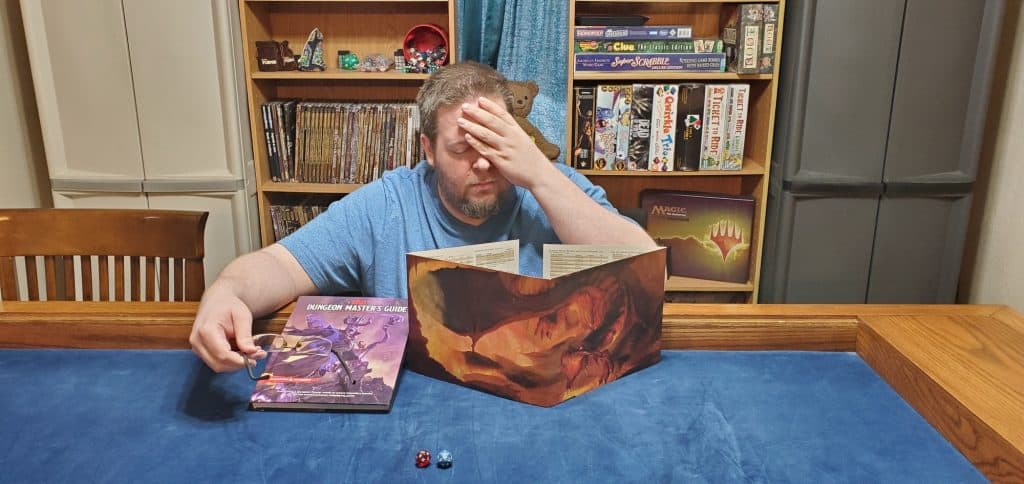
Others say it’s clearly the most overpowered of all the feats. Think style of DM probably has a lot to do with those vastly different opinions? Because I think that’s pretty likely.
There are six feats that consistently turn up as the bane of the DM’s existence in a 5th edition Dungeons & Dragons game. Those are: Lucky, Observant, Alert, Keen Mind, Spell Sniper, and Sharp Shooter. However, none of these should ever be game-wrecking.
Read on to learn more on each – and how DMs can counter abuse of these feats.
5E Feats Always Challenging to the DM
These are the feats that are designed to give players the ability to go Super Saiyan and wreak havoc. There are only two that always seem to pop up, but a third could arguably make this cut of headache inducing 5E feats.
#1: Lucky
I think the only reason more people don’t complain about this is because so many players overlook it. The lucky feat 5e rolls out is a ridiculously powerful feat for even one player to have, much less when the rest of the table catches on and everybody grabs it.
Lucky gives you 3 Luck Dice. You are allowed to spend a luck dice to roll a d20. This roll can happen AFTER you see the result of your first roll (but you MUST let the DM know you’re using Luck before he/she tells the result of this roll).
A d20 can be rolled when
- You roll for attack
- You roll an ability check
- You roll a saving throw
- An enemy rolls an attack against you
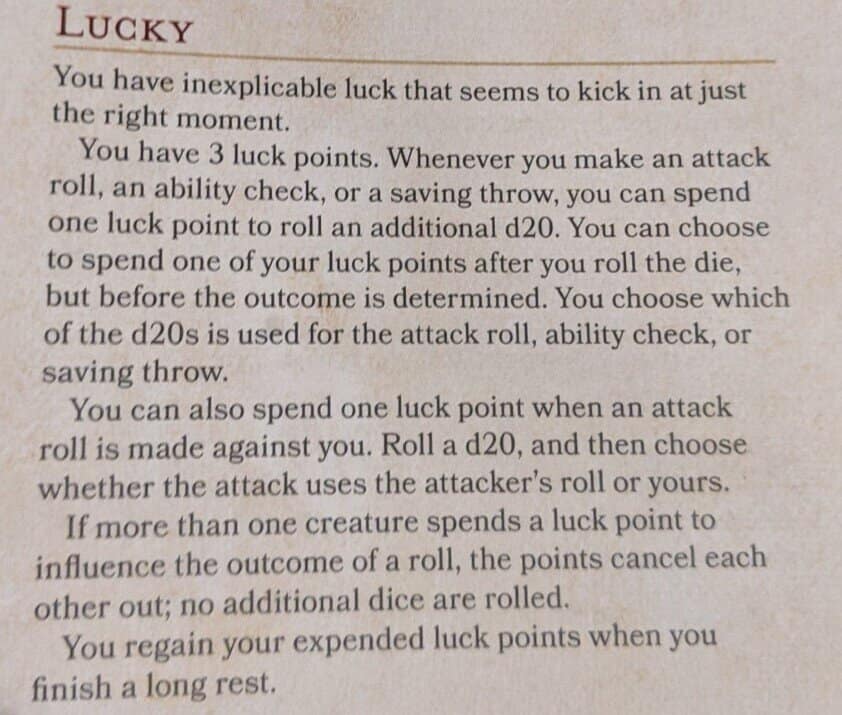
This leads to an insane number of times where a botched save or check becomes a success. That’s a game changer right there.
And it can be done three times between long rests.
When an enemy boss crits on an attack – your player then just has them re-roll. That crit hit might become a straight out miss. And if they have all their dice, they can do that THREE times in one fight.
Lucky is incredibly powerful even in the hands of one player. If you have a party of 2-3 they can pretty much dictate every fight, save, or labyrinth navigation.
Lucky is bonkers broken. In the hands of a Halfling who gets to re-roll 1’s or a divination wizard who has all kinds of ways to mess with dice at high levels, and you can imagine how quickly this can get out of control.
To me, hands down, both from a “theoretical” look and from having seen it in action during multiple campaigns with different DMs: Lucky can be a game wrecker.
DM Solution: There are some limited options here if you feel like Lucky is too broken for the type of campaign you’re running, or if it breaks your ability to improv.
- Ban it from the beginning: In a campaign I ran chaotic luck (“Norse luck“) was a major theme and so having players able to just overturn luck rolls went against the very nature of the campaign. So I let them know that was the one feat off limit, and for the halfling I said the 1-reroll was taken out but he could name a suitable replacement since I was taking away a racial feature. So he chose Alert. Because of course he did.
- Let them know there would be specific times or situations where Lucky rerolls would not be allowed. This is sort of iffy because they’ll want specifics early, and if you miss something, it’s opening up arguments later whereas the ban from the beginning is acceptable because it’s setting expectations for the TRPG from the beginning.
- Remember that any feat the players have access to, NPCs also have access to.
For more information on this feat, check out our full 5E Lucky Feat Guide. Or as a DM you can check out our more thorough answer to this question by checking out: How to Deal with Lucky Feat as a DM
#2: Observant
The first parts of the 5e observant feat don’t seem too intimidating, but that last point is killer. However, when you put this feat into practice it breaks a lot of games at low, middle, and high levels.
What this feat does:
- Lets you add +1 to INT or WIS (can be useful for an odd number, but generally yawn)
- If a creature is speaking a language you can understand, you can read its lips (situationally killer if used by a PC who uses the spell Tongues on themselves)
- +5 to passive Wisdom/Perception and +5 to passive Intelligence/Investigation….WTF?
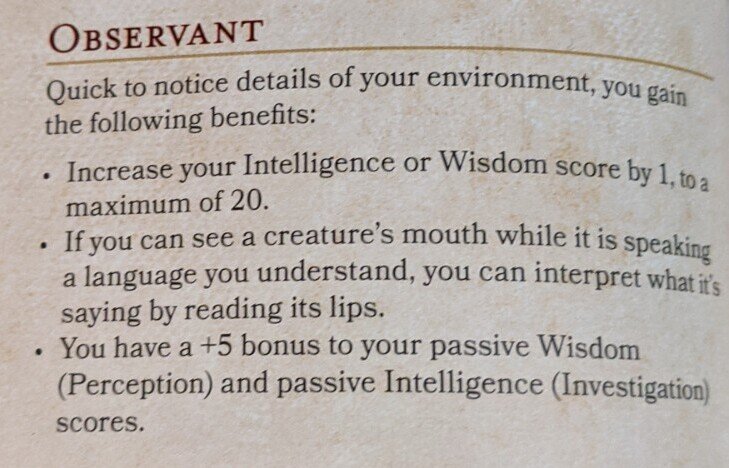
Granted, in a hack and slash dungeon crawl this won’t do much. But if the DM isn’t playing extremely loose by the mechanics and the table understands passive perception as well as investigation skill, then this is killer to a player that has high scores in both. Good luck surprising that rogue. It’s never going to happen.
Want hidden clues? They’re always going to be found.
You had some hidden traps? Aw, that’s cute, that +5 to an already +10 investigation just ruined your day.
This heavily dictates what types of games you can and can’t run as it entirely eliminates some of the various tropes, traps, and setups that DMs love to use and tend to be expected as part of a D&D adventure.
For DMs with limited range that’s a huge issue. Even for those who like to improve, adding a +5 to passive perception when there might be a monk, ranger, or rogue that already has a high passive perception even at low level can really mess up your game.
It’s hard to hide clues when your level five monk has a 21 or 22 passive perception.
DM Solution: Observant has a few more options for dealing with it than game breaker Lucky.
- Don’t use passive perception – bit of a cheat, but something that many DMs do anyway because they simply don’t understand how passive perception works in 5E.
- Have an anti-magic field the heroes (PCs) stand in when appropriate (if trying to infiltrate a guild, or in the presence of royalty, for example) since that would nullify any spell cast of Tongues
- Don’t rely on any type of ambush or hidden from sight situation since the passive perception hammers that. Unless you WANT to give your skill players some moments where they stick out from the crowd, in which case this “disadvantage” lets your players shine to give them their moment…before you bring down the hammer somewhere else
5E Feats Situationally Challenging to the DM
These are feats that can be challenging. Some very much so in the right circumstances. Just to clarify: just because the feat ruins a DM’s day doesn’t mean it’s broken. Many of these feats are great for players and give that extra bit of power or edge they need for a challenging campaign.
#1: Alert
I’ll be honest: this one is almost in the top list. If you have a rogue or ranger designed to be stealthy, then go ahead and pop this up to the “always challenging” tier. This was right up there with Lucky as one of the first two that I wanted as a player.
There are some ways to deal with the Alert feat, especially if the DM understands how surprise rounds work.
But many don’t and that makes alert even more powerful and potentially game-breaking for some less veteran DMs.
What this feat does:
- +5 to initiative
- While you are conscious you can’t be surprised
- Other creatures do NOT get advantage on attack rolls because you don’t see them
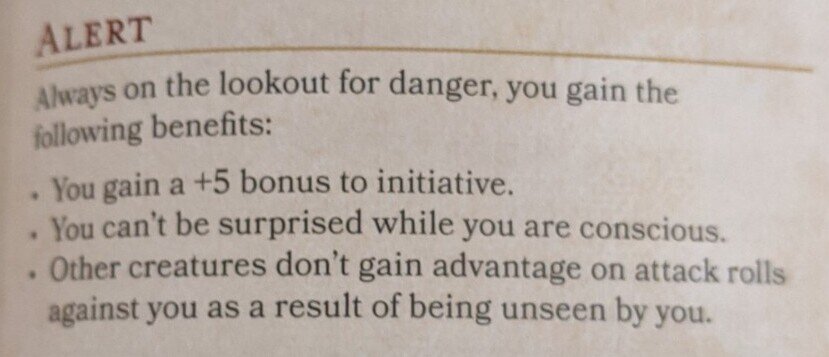
This is incredibly powerful. It can patch up a player with deficiencies and make them really solid in multiple areas. But put this with a rogue or ranger who already has really high initiative bonus and skills that make them particularly dangerous even at low levels and this is crazy. Enemy NPC rogue? Well you don’t get advantage on that first attack so kiss the sneak attack bonus good-bye.
Have an ambush up ahead for the party? This can still work – but you’re not catching everyone flat footed. Every PC with Alert gets to act in the Surprise Round…and that +5 bonus means they often go even before most the ambushers.
This is an incredibly powerful feat that can heavily affect the interaction (and outcome) of any given battle. It can also cause wrenches in DM plans like “Ambush but then talk them into coming along peacefully.” If a wizard can throw a fireball or a ranger can sharpshoot the leader with a critical hit plus hunter’s mark…well things can get out of hand fast.
DM Solution:
- Understanding how surprise rounds work. Most DMs who viscerally hate this feat don’t run surprise rounds correctly. An alert player can’t be surprised – but that doesn’t let the party off the hook. He can yell watch out as a free action, but the surprise round (from say an ambush) still takes place. The player with alert gets a turn in that round. No one else might. In a surprise round the mechanics are that every player has a turn – but the players with the Surprised state simply can’t act. So one player with Alert does NOT cancel out an ambush’s surprise round.
- Be creative in your confrontations. Look for ways to split the party. Try something completely different, like a fearless scout just walking into camp and looking around. There are workarounds. At low level sleep spell traps were one of my favorites.
- Allow that player to shine – then once the whole party gets Alert just stop planning ambushes.
For more information on this feat, check out our full 5E Alert Feat Guide by clicking that link.
#2: Keen Mind
This was an interesting to me because many DMs rage against Keen Mind as a feat that is straight up broken…but many of the tables I’ve played at consider it so useless that no one even considered picking it up.
So how can Keen Mind be viewed so differently among DMs? What’s the truth of the matter?
Keen Mind is an interesting feat and I can honestly see both sides of it.
What this feat does:
- Increase intelligence by 1 to a maximum of 20 (meh)
- You always know which direction is north
- You always know the number of hours before the next sunrise or sunset
- You can accurately recall anything you have seen or heard in the past month
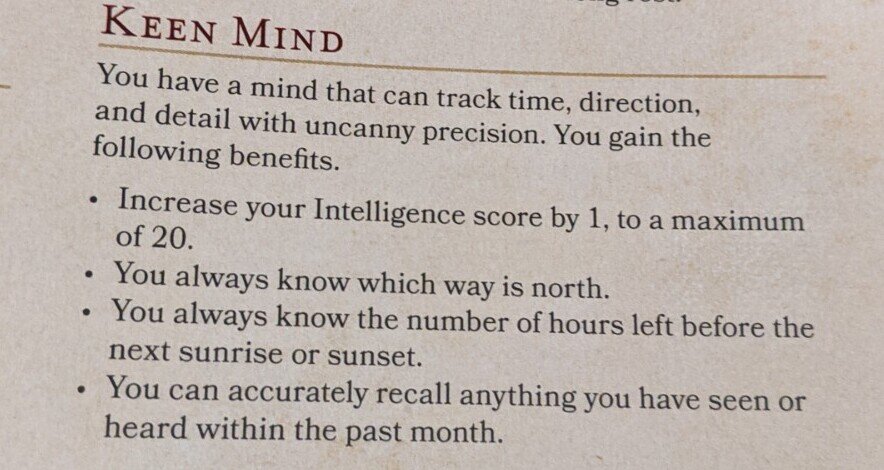
In certain situations or for certain campaigns this could be hard to deal with. A hardcore surviving while running through the woods after jailbreak situation – yeah this would be an insanely effective feat.
The biggest power of Keen Mind is clearly the fourth point. If you’re in a short compact campaign there might only be so much you can do. However for many campaigns there can be long times of travel. If you spent a month and a half on a boat that might pass by in a sentence – but it definitely affects the feat.
In some campaigns this is just kind of useless. In others it could be really strong. For a detail or story heavy DM looking for bits of mystery or dropping hints – the fourth point of keen mind can really screw things up.
In my last group it was used to the DM’s consternation to avoid taking notes. On the plus side, since this was a campaign that took over two years’ in-game time they may have blown up short-term mysteries or clues, but the lack of notes led to long-term unfinished issues to come back to haunt them.
So needless to say, there are solutions.
DM Solution: In some campaigns you won’t need these workarounds. In some 5E campaigns you
- Interdimensional spaces are great (no direction, no sunrise/sunset). Also confusing a player in a maze with “North is straight ahead of you. Now it’s behind you. After you turn it switched from left to right,” is a great way to let them know a Minotaur is coming.
- Does remembering something seen or heard come with a successful insight check from earlier? I’d say probably yes…but you could tiptoe that line and say not. I would definitely rule that if the insight roll wasn’t a success then that player’s mind is blocked from trying to understand it a different way (no limitless insight rolls).
- Time is your friend. Think long-term mysteries or clues versus short-term. One month isn’t that long if they are traveling a world without Teleportation Circles
For more information on this feat, check out our full 5E Keen Mind Feat Guide.
#3: Spell Sniper
If you’ve paid attention to the many versions of the machine gun Eldritch Blast builds of Sorcerer/Warlock, you’ve run across the one that adds extra distance or even lets other classes put their variance on it.
Magic is ultra powerful in 5th Edition Dungeons & Dragons, especially if the DM is going by the original spirit of “a relatively low magic world” (there are plenty of reasons why we all think this was a mistaken approach – as later corrections with new books have caught onto). So anything that adds a lot of additional distance to spells being cast can be incredibly powerful.
Add the spell sniper feat to a warlock’s Eldritch Spear and hello fully by the rules’ lawyer headache with a warlock who can hit from ungodly distances.
Spell sniper is also a great pick up for a charismatic wizard who doesn’t mind some of that Eldritch blast action…plus double distance on all the other spells with an attack roll.
What this feat does:
- Learn one cantrip that requires an attack roll (this can be from any class)
- Your distance is DOUBLED for any attack spell that requires an attack roll
- Ranged spells ignore half cover and three quarters cover

This is not overpowered unless optimized in a very power gaming sort of way. That being said, spell sniper is a feat that can ruin a DM’s day just because it is a versatile and powerful feat for a variety of classes in 5th Ed.
DM Solution: Spell sniper shouldn’t be neutered too much. Magic casters are meant to be powerful, but sometimes you need to work around the roughest problems it can create.
- Require Eyes of the Eagle to effectively use the insanely distanced spell sniper + Eldritch Spear combination accurately
- Even though these spells ignore cover, that doesn’t mean you can SEE enemies that far away in terrain like jungle, thick woods, or the middle of a sand storm in the desert (or blizzard in the mountains)
- Barbarians can tank a LOT of damage even from multiple distance spells
- Have “boss battles” in confined spaces
#4: Sharpshooter
This is one of those feats that I think is 100% legitimate and actually necessary (though if you had wanted to make ranger the “archer” class and fixed its underpowered factor, making sharp shooter a mid to late level class feature vs feat would have been the way to go – just saying) but it is a feat that will allow the bard archer, fighter archer, or ranger to cause some serious issues at the right time in the campaign.
Assuming the ranged player has a long bow, which they will most likely have – their distance to hit a shot is insane. If you are trying to paint the scene as DM and get caught up in a flourish of poetry talking about the enemy force cresting a hill from the distance on horseback with the chieftain clearly in view…and your sharp shooter in the party will 100% realize they have four free shots before the enemy gets to combat.
That’s a bad time for the enemy leading the charge.
It’s not a broken feat at all, but if you forget about Sharpshooter as DM man it will come at you during the most inopportune times.
What this feat does:
- Attacking at long range no longer imposes disadvantage for ranged weapons
- You can ignore half cover and three quarters cover
- You can choose to take a -5 chance of hitting to add a +10 to the damage if you hit
This is an absolute necessity for a ranger or a fighter designed to be an archer.
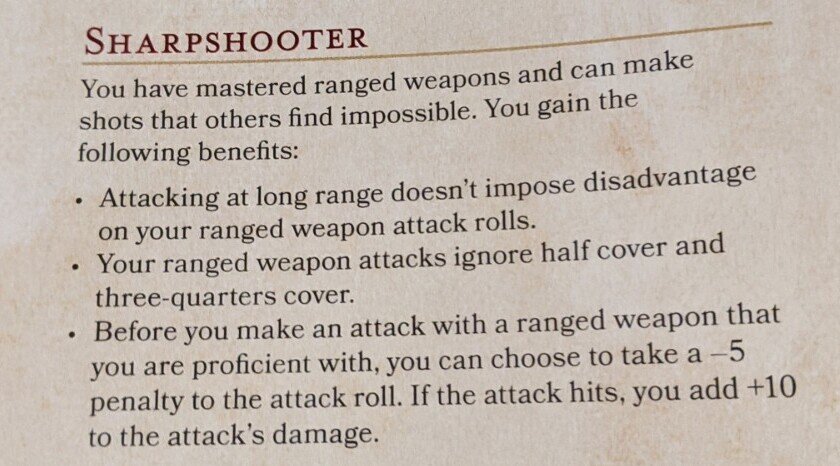
DM Solution: Give the player some chances to shine, but don’t charge from 600 feet away. Give them a free shot or two, then close the distance.
- Force a player to use the “Eyes of the Eagle” to effectively use at full length. If you want to hit targets at 600 feet with a long bow, it’s not unreasonable to make sure you can see them clearly – and using one magic item slot isn’t the worst compromise (which I often remove at a certain level due to “training” or giving it as a high level boost)
- Don’t get into a long distance bow fight with rangers/archers
- Have enemy NPCs who have magic use spells like sleet storm or darkness to get around the “cover” issue and still add a challenge
- Don’t sweat it too much. This is one that’s easy to work around.
No Feat Should Be Game Ruining
While these are the feats that give players the best ability to give the DM a headache in the good-natured rivalry that develops on most good tables, no feat should ever be game ruining. The truth is that feats are actually optional (as technically are all the rules – DM has final say above all else, as the rule books indicate), but even then there are ways around them.
Even when there is a competitive DM vs. Players relationship, it should be fun. Sometimes the DM gets one over on the party, sometimes the party shines and just wrecks the DM’s plans. This is a good sign a campaign is going well. There are real stakes, players get their time to shine, and once in a while the DM gets back at a player or party in a funny way that creates a memorable story.
Don’t be afraid to shift feats as needed – just make sure the rules are set up front. When I made it clear that Lucky wasn’t allowed, and explained why it wasn’t, nobody had a problem with it.
A little communication can go a long way so everyone can have a great game.
Other DnD Articles You May Enjoy
- Best Low Level Utility Spells 5E
- Sorcerer Vs. Wizard 5E
- Barbarian Vs. Fighter 5E
- 5E Crossbow Expert
- Fey Touched Feat
- DnD Healer Feat

Proud to embrace the locally created moniker of “Corrupt Overlord” from one of the all time great Lords of Waterdeep runs, Shane is one member of the Assorted Meeples crew and will be hard at work creating awesome content for the website. He is a long-time player of board games, one time semi-professional poker player, and tends to run to the quirky or RPG side of things when it comes to playing video games. He loves tabletop roleplaying systems like Dungeons & Dragons, Pathfinder, Werewolf, Fate, and others, and not only has been a player but has run games as DM for years. You can find his other work in publications like Level Skip or Hobby Lark.


